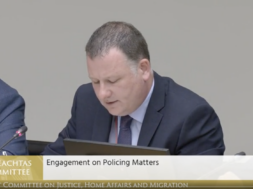10 December, 2013
Minister Shatter welcomes publication of CSO second Probation Recidivism Study 2008-2012
The Minister for Justice, Equality and Defence, Alan Shatter TD, today welcomed the publication of the second Central Statistics Office Report on Recidivism in the Probation Service for the 2008 cohort.
Speaking today Minister Shatter said, “This independent assessment by the Central Statistics Office of the impact of noncustodial measures on rates of re-offending is very important for informing the effectiveness of community sanctions. Specifically, this study focuses on a cohort of offenders from 2008, and shows the recidivism or re-offending rate of this cohort after a three year period. These categories of offenders did not go to prison but were given an alternative sanction by the Courts, such as a Probation Order or a Community Service Order. The results show that almost 60% of offenders given one of these alternative sanctions by the Courts in 2008 had not re-offended after three years.”
The study’s findings indicate that the recidivism or re-offending rate was 41% for the particular cohort of offenders who had been under probation supervision in the three years following the imposition of an order by the court. When compared with the equivalent cohort from the 2007 study there is a fall in recidivism of almost 8%.
Commenting on this Minister Shatter said, “I consider a 41% recidivism rate to be too high. This report is an indicator of how things stood in 2008 and it is my view that the probation recidivism rate can, and should, be lower. It is my hope that the changes I have introduced with regard to the Community Service Scheme will be measured in future studies by even lower recidivism rates. These changes serve to reinforce the positive effect alternative sanctions can have in making our communities safer.”
Minister Shatter added, “This second study provides reliable recidivism data on offenders under probation supervision and on community service orders in 2008 and considers variations in recidivism as they relate to the type of original sanction imposed, gender and age of offenders, category of offence and subsequent re-offence. I welcome this study and the contribution it makes to the constructive assessment of the effectiveness of non-custodial sanctions.”
Males made up almost 87% of the total population assessed and had a higher recidivism rate than females. Recidivism rates, in most cases, were seen to decrease as the offender’s age increased.
Public order offences are the most common original offences. Public Order is also the most common offence on reconviction.
The re-offending rate among young offenders under 18 years of age is high at 58.1% but reduced by 10.4% in comparison with the equivalent population in the 2007 study. As the overall population is small, even a small change in re-offending and in additional convictions can lead to significant variation in the reported outcome.
The Minister acknowledged that this report follows on the two previous reports based on Probation Service and Irish Prison Service data. He commended the work of the Central Statistics Office in their continued partnership with the Probation Service in these valuable studies. The reports provide an overview of community supervision outcomes which will inform the work of the Probation Service in helping to make communities safer.
The report is available on the Central Statistics Office website at www.cso.ie.
ENDS
Note for Editors:
The Probation Service is the lead agency in the assessment and management of offenders in the community. The Probation Service plays an important role in helping to reduce the level of crime by working with offenders to change their offending behaviour and make good the harm done by their offending. The Probation Service generally becomes involved in the criminal justice process between the trial and sanction phases, often in cases where a court requires a pre-sanction assessment to assist in deciding on an appropriate sanction. In suitable cases the court may consider placing an offender on probation supervision or community service as an alternative to imposing a prison sentence.
The publication of the first CSO/Probation Recidivism study in 2012 meant significant progress for the Probation Service in the production of research based management information. There had previously been an absence of research on recidivism of offenders under the management of the Probation Service. The Central Statistics Office and the Probation Service therefore began a process of exploring the possible synergies between their extensive datasets. Data on offenders who had been given probation supervision or community service in 2007 was used to conduct the first study. Data on offenders who had been given probation supervision or community service in 2008 was used in the study published today.
The 2007 data in this report is based on an updated revision of the data published in 2012.
It is understood that the CSO will publish data on prison recidivism later in the month.









